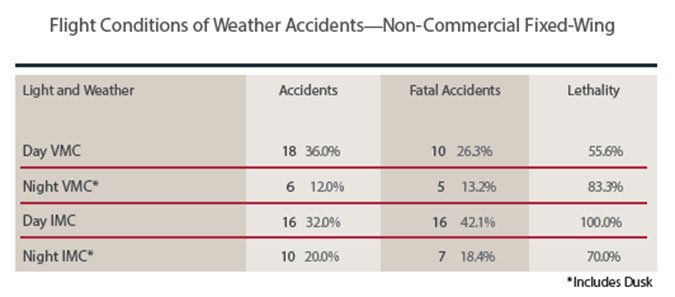Continued VFR into IMC accidents have been part of the general aviation accident scene since before I started flying more than 50 years ago. Some headway in reducing these accidents was made when private pilot applicants were required to demonstrate basic instrument proficiency beginning in the early 1960s. Cockpit technology has also improved, with even basic training aircraft equipped for instrument flight and devices such as autopilots and weather data link becoming more prevalent.
On the other hand, there is a much higher percentage of high performance aircraft in the general aviation fleet than 50 years ago, and more non-instrument-rated pilots are flying longer distances in higher performance aircraft. As a result, the prevalence of VFR-into-IMC accidents is still very high.

Not Standing Still
I should point out that neither the FAA nor the general aviation industry have ignored the problem of continued VFR into IMC. In March 2000, the Weather Joint Safety Implementation Team (JSIT) issued a report on reducing general aviation weather accidents, recommending 16 programs targeting reductions in fatal GA weather accidents. In particular, they emphasized three high-priority efforts:
• Providing better graphical weather data, both in the airplane and on the ground.
• Improving scenario-based weather training and testing, with accompanying guidance material improvements, and
• Minimizing regulatory “impediments” to proper weather decision-making and hazard reporting.
I believe we can recognize some improvement along these lines fifteen years after the Weather JSIT report was issued. The wide variety of portable and panel-mount weather data link systems now available show great progress on the first bullet. However, little has happened with the third one, which relates to issues such as reporting known icing and flight service stock warnings such as “VFR not recommended.”
As for the second bullet, it seems to finally be approaching some degree of realization as the FAA prepares to introduce airman certification standards (ACS) to replace the current practical test standards (PTS). The ACS system will integrate knowledge, skill and risk management proficiency in one document and emphasize applicant ability to integrate these three elements—not just rote performance on a separate knowledge test and on stock training maneuvers—in accomplishing safe flight operations.
Given all of this follow-on and planned activity, shouldn’t we expect to see significant reductions in VFR into IMC accidents? Before answering that question we must consider the real reasons that these accidents continue to happen.
Real Root Causes
I wanted a little more data to support what I saw in ASI’s Nall Report. I especially wanted to know why pilots have fatal VFR into IMC accidents. Typically, as we’ll soon see, these accidents often are classified as either in-flight loss of control (LOC-I) or controlled flight into terrain (CFIT) events. These tags, however, merely describe the final event in the accident sequence, not its true root cause.
To create more insight into continued VFR into IMC accidents, I used a technique that readers of my previous articles in this journal should be familiar with. My starting premise is that the overwhelming majority of general aviation fatal accidents occur due to poor risk management on the part of the pilot.
To test this theory with VFR into IMC accidents I used NTSB accident data to surface some of these accidents. I looked at a 20-year period—1992-2011, inclusive—and selected fatal GA, Part 91, airplane-only accidents. I added the narrative descriptor “VFR into IMC.” Typically, this technique will only surface a small number of the total accidents that are eventually attributed to a particular causal factor, due to the way the NTSB Factual Narrative and Probable Cause reports are written. In my sample, I only ended up with 11 accidents.

I next reviewed all 11 reports and applied a simple rule: If the pilot was aware or should have been aware of the hazard that was the proximate cause of the accident—IMC or marginal VMC weather—and then failed to properly assess and mitigate the risk, then we may properly say a root cause of this accident was poor risk management.
In my sample of 11 accidents, there was sufficient data pointing to all of them involving poor risk management as a root cause. In three of them—each involving non-instrument-rated pilots—control of the airplane was lost. The other eight involved CFIT events: The pilot flew a perfectly good airplane into the ground under control. Curiously, five of the 11 pilots held instrument ratings. Three of the accidents occurred in mountain passes; two were at night. In several cases, non-instrument rated pilots took off into very low overcasts.
As I stated, my criteria was that the hazard had to be identifiable by the pilot and in all 11 accidents this was clearly the case. This begs the question: why would a pilot attempt VFR operations under such conditions?
Train for the Real World
It’s my firm belief that the current pilot training culture and system is not up to the job of training pilots to operate safely in the real world. Our current system is maneuver-based, with rote performance on the knowledge (multiple-choice) test, and emphasizes regulatory compliance instead of safe operations. Training must move more fully toward scenario-based learning, with effective risk management applied rather than mere compliance with regulatory minimums. We’ve taken steps in that direction, but much more can be done. Some ideas:
• Training should emphasize the extreme hazards of operating in marginal weather without the proper training (i.e., an instrument rating) and procedures. We tend to soft pedal general aviation’s hazards, and emphasize the regulatory weather minimums. In my opinion, operating VFR away from the airport under conditions of 1000-foot ceilings and three miles visibility is hazardous for most pilots most of the time.
• Cross-country training should emphasize scenarios and actions enabling pilots to make timely diverts. For example, most dual cross-country training flights should not end up at the planned destination. An instructor might say to plan for a flight at 2500 agl with an overcast at 3000 agl, then inform the student that the ceiling will drop 200 feet per minute. The student must then accomplish a timely divert before the “clouds” reach the ground.
• Autopilots are more prevalent than ever. Students should be taught to use them early in the game and—especially—how they can save the day if the student ends up in cloud. And technology may be getting a bad rap lately, but proper use of equipment like data-linked weather can help pilots to avoid such hazards.
• Finally, and above all else, students must be taught practical, effective risk management techniques allowing them to identify, assess and mitigate weather and other hazards.
Robert Wright is a former FAA executive and President of Wright Aviation Solutions LLC. He is also a 9600-hour ATP with four jet type ratings and holds a Flight Instructor Certificate. His opinions in this article do not necessarily represent those of clients or other organizations that he represents.




